Facile Synthesis of ZnSe/Co3O4 Heterostructure Nanocomposites for the Photocatalytic Degradation of Congo Red Dye
Abstract
1. Introduction
2. Materials and Methods
2.1. Chemicals
2.2. Synthesis of ZnSe
2.3. Synthesis of Co3O4
2.4. Preparation of the ZnSe/Co3O4 Heterostructure
2.5. Characterization
2.6. Photocatalytic Studies
3. Results
3.1. Phase Analysis
3.2. Morphological Analysis
3.3. Elemental Analysis
3.4. Optical Studies and Bandgap Estimation
- hv = photon energy (eV);
- α = absorption coefficient;
- B = constant relative to material;
- Eg = bandgap;
- n = ½ for an indirect transition and 2 for direct transition.

- Ec = CB energy;
- Ev = VB energy;
- Eg = calculated bandgap of the material.
3.5. Photocatalytic Activity
4. Conclusions
Author Contributions
Funding
Data Availability Statement
Acknowledgments
Conflicts of Interest
References
- Rochkind, M.; Pasternak, S.; Paz, Y. Using Dyes for Evaluating Photocatalytic Properties: A Critical Review. Molecules 2015, 20, 88–110. [Google Scholar] [CrossRef] [PubMed]
- Sakthivel, S.; Neppolian, B.; Shankar, M.V.; Arabindoo, B.; Palanichamy, M.; Murugesan, V. Solar Photocatalytic Degradation of Azo Dye: Comparison of Photocatalytic Efficiency of ZnO and TiO2. Sol. Energy Mater. Sol. Cells 2003, 77, 65–82. [Google Scholar] [CrossRef]
- Ehsan, M.F.; Bashir, S.; Hamid, S.; Zia, A.; Abbas, Y.; Umbreen, K.; Ashiq, M.N.; Shah, A. One-Pot Facile Synthesis of the ZnO/ZnSe Heterostructures for Efficient Photocatalytic Degradation of Azo Dye. Appl. Surf. Sci. 2018, 459, 194–200. [Google Scholar] [CrossRef]
- Prasannan, A.; Udomsin, J.; Tsai, H.-C.; Wang, C.-F.; Lai, J.-Y. Robust Underwater Superoleophobic Membranes with Bio-Inspired Carrageenan/Laponite Multilayers for the Effective Removal of Emulsions, Metal Ions, and Organic Dyes from Wastewater. Chem. Eng. J. 2020, 391, 123585. [Google Scholar] [CrossRef]
- Rashidi, H.R.; Sulaiman, N.M.N.; Hashim, N.A.; Hassan, C.R.C.; Ramli, M.R. Synthetic Reactive Dye Wastewater Treatment by Using Nano-Membrane Filtration. Desalination Water Treat. 2015, 55, 86–95. [Google Scholar] [CrossRef]
- Tung, C.-H.; Shen, S.-Y.; Chang, J.-H.; Hsu, Y.-M.; Lai, Y.-C. Treatment of Real Printing Wastewater with an Electrocatalytic Process. Sep. Purif. Technol. 2013, 117, 131–136. [Google Scholar] [CrossRef]
- Electrocatalytic Degradation of Bromocresol Green Wastewater on Ti/SnO2-RuO2 Electrode|Water Science and Technology|IWA Publishing. Available online: https://iwaponline.com/wst/article-abstract/75/1/220/19781 (accessed on 4 December 2020).
- Charerntanyarak, L. Heavy Metals Removal by Chemical Coagulation and Precipitation. Water Sci. Technol. 1999, 39, 135–138. [Google Scholar] [CrossRef]
- Ali, I.; Gupta, V.K. Advances in Water Treatment by Adsorption Technology. Nat. Protoc. 2006, 1, 2661. [Google Scholar] [CrossRef] [PubMed]
- Bhatia, D.; Sharma, N.R.; Singh, J.; Kanwar, R.S. Biological Methods for Textile Dye Removal from Wastewater: A Review. Crit. Rev. Environ. Sci. Technol. 2017, 47, 1836–1876. [Google Scholar]
- Sonkusare, V.N.; Chaudhary, R.G.; Bhusari, G.S.; Mondal, A.; Potbhare, A.K.; Mishra, R.K.; Juneja, H.D.; Abdala, A.A. Mesoporous Octahedron-Shaped Tricobalt Tetroxide Nanoparticles for Photocatalytic Degradation of Toxic Dyes. ACS Omega 2020, 5, 7823–7835. [Google Scholar] [CrossRef] [PubMed]
- Lam, S.-M.; Sin, J.-C.; Abdullah, A.Z.; Mohamed, A.R. Degradation of Wastewaters Containing Organic Dyes Photocatalysed by Zinc Oxide: A Review. Desalination Water Treat. 2012, 41, 131–169. [Google Scholar] [CrossRef]
- Shanker, U.; Jassal, V.; Rani, M. Catalytic Removal of Organic Colorants from Water Using Some Transition Metal Oxide Nanoparticles Synthesized under Sunlight. RSC Adv. 2016, 6, 94989–94999. [Google Scholar] [CrossRef]
- Kiwaan, H.A.; Atwee, T.M.; Azab, E.A.; El-Bindary, A.A. Photocatalytic Degradation of Organic Dyes in the Presence of Nanostructured Titanium Dioxide. J. Mol. Struct. 2020, 1200, 127115. [Google Scholar] [CrossRef]
- Al-Mamun, M.R.; Kader, S.; Islam, M.S.; Khan, M.Z.H. Photocatalytic Activity Improvement and Application of UV-TiO2 Photocatalysis in Textile Wastewater Treatment: A Review. J. Environ. Chem. Eng. 2019, 7, 103248. [Google Scholar]
- Effect of Various Amounts of Graphene Oxide on the Degradation Characteristics of the ZnSe/Graphene Nanocomposites. Appl. Surf. Sci. 2015, 358, 63–69. [CrossRef]
- Raza, N.; Raza, W.; Gul, H.; Kim, K.-H. ZnO-ZnTe Hierarchical Superstructures as Solar-Light-Activated Photocatalysts for Azo Dye Removal. Environ. Res. 2020, 194, 110499. [Google Scholar] [CrossRef] [PubMed]
- Shawky, A.; El-Sheikh, S.M.; Gaber, A.; El-Hout, S.I.; El-Sherbiny, I.M.; Ahmed, A.I. Urchin-like CuS Nanostructures: Simple Synthesis and Structural Optimization with Enhanced Photocatalytic Activity under Direct Sunlight. Appl. Nanosci. 2020, 10, 2153–2164. [Google Scholar] [CrossRef]
- Korala, L.; Germain, J.R.; Chen, E.; Pala, I.R.; Li, D.; Brock, S.L. CdS Aerogels as Efficient Photocatalysts for Degradation of Organic Dyes under Visible Light Irradiation. Inorg. Chem. Front. 2017, 4, 1451–1457. [Google Scholar] [CrossRef] [PubMed]
- Aziz, A.; Ali, N.; Khan, A.; Bilal, M.; Malik, S.; Ali, N.; Khan, H. Chitosan-zinc Sulfide Nanoparticles, Characterization and Their Photocatalytic Degradation Efficiency for Azo Dyes. Int. J. Biol. Macromol. 2020, 153, 502–512. [Google Scholar] [CrossRef]
- Ayodhya, D.; Veerabhadram, G. A Review on Recent Advances in Photodegradation of Dyes Using Doped and Heterojunction Based Semiconductor Metal Sulfide Nanostructures for Environmental Protection. Mater. Today Energy 2018, 9, 83–113. [Google Scholar] [CrossRef]
- Dong, H.; Li, J.; Chen, M.; Wang, H.; Jiang, X.; Xiao, Y.; Tian, B.; Zhang, X. High-Throughput Production of ZnO-MoS2-Graphene Heterostructures for Highly Efficient Photocatalytic Hydrogen Evolution. Materials 2019, 12, 2233. [Google Scholar] [CrossRef]
- Ritika; Kaur, M.; Umar, A.; Mehta, S.K.; Singh, S.; Kansal, S.K.; Fouad, H.; Alothman, O.Y. Rapid Solar-Light Driven Superior Photocatalytic Degradation of Methylene Blue Using MoS2-ZnO Heterostructure Nanorods Photocatalyst. Materials 2018, 11, 2254. [Google Scholar] [CrossRef] [PubMed]
- Shanmugaratnam, S.; Velauthapillai, D.; Ravirajan, P.; Christy, A.A.; Shivatharsiny, Y. CoS2/TiO2 Nanocomposites for Hydrogen Production under UV Irradiation. Materials 2019, 12, 3882. [Google Scholar] [CrossRef] [PubMed]
- Ahmad, I. Comparative Study of Metal (Al, Mg, Ni, Cu and Ag) Doped ZnO/g-C3N4 Composites: Efficient Photocatalysts for the Degradation of Organic Pollutants. Sep. Purif. Technol. 2020, 251, 117372. [Google Scholar] [CrossRef]
- Mohammed, R.; Ali, M.E.M.; Gomaa, E.; Mohsen, M. Green ZnO Nanorod Material for Dye Degradation and Detoxification of Pharmaceutical Wastes in Water. J. Environ. Chem. Eng. 2020, 8, 104295. [Google Scholar] [CrossRef]
- Choudhary, S.; Sahu, K.; Bisht, A.; Satpati, B.; Mohapatra, S. Rapid Synthesis of ZnO Nanowires and Nanoplates with Highly Enhanced Photocatalytic Performance. Appl. Surf. Sci. 2020, 541, 148484. [Google Scholar] [CrossRef]
- Rani, E.G.D.S.; Kumar, G.A.; Steplinpaulselvin, S.; Rajaram, R.; Silambarasan, T.S.; Lydia, S.L.; Chen, Y. Survival Assessment of Simple Food Webs for Dye Wastewater after Photocatalytic Degradation Using SnO2/GO Nanocomposites under Sunlight Irradiation. Sci. Total Environ. 2020, 721, 137805. [Google Scholar] [CrossRef]
- Zia, A.; Hamid, S.; Ehsan, M.F.; Allah, S.U.; Ashiq, M.N.; Shah, A. Congo Red Photomineralization over Co3O4/CoTe Common Cation Nanocomposites. J. Mater. Sci. Mater. Electron. 2018, 29, 20271–20279. [Google Scholar] [CrossRef]
- Sharma, M.; Poddar, M.; Gupta, Y.; Nigam, S.; Avasthi, D.K.; Adelung, R.; Abolhassani, R.; Fiutowski, J.; Joshi, M.; Mishra, Y.K. Solar Light Assisted Degradation of Dyes and Adsorption of Heavy Metal Ions from Water by CuO–ZnO Tetrapodal Hybrid Nanocomposite. Mater. Today Chem. 2020, 17, 100336. [Google Scholar] [CrossRef]
- Ehsan, M.F.; Qudoos, S.; Ahmad, Z.; Hamid, S.; Arfan, M.; Zia, A.; Umbreen, K.; Ashiq, M.N.; Tyagi, D. ZnTe/ZnSe Heterostructures: In-Situ Synthesis, Characterization and Photocatalytic Activity for Congo Red Degradation. SN Appl. Sci. 2019, 1, 197. [Google Scholar] [CrossRef]
- Chen, Y.; Qian, J.; Wang, N.; Xing, J.; Liu, L. In-Situ Synthesis of CNT/TiO2 Heterojunction Nanocomposite and Its Efficient Photocatalytic Degradation of Rhodamine B Dye. Inorg. Chem. Commun. 2020, 119, 108071. [Google Scholar] [CrossRef]
- Kim, M.-J.; Choi, Y.I.; Joo, S.W.; Kang, M.; Sohn, Y. Synthesis of Er and Yb-Doped Cubic and Hexagonal Phase ZnSe Nano-Assembled Microspheres and Their Photocatalytic Activities. Ceram. Int. 2014, 40, 16051–16059. [Google Scholar] [CrossRef]
- Xue, X.-Y.; Yuan, S.; Xing, L.-L.; Chen, Z.-H.; He, B.; Chen, Y.-J. Porous Co3O4 Nanoneedle Arrays Growing Directly on Copper Foils and Their Ultrafast Charging/Discharging as Lithium-Ion Battery Anodes. Chem. Commun. 2011, 47, 4718–4720. [Google Scholar] [CrossRef]
- Wang, G.; Shen, X.; Horvat, J.; Wang, B.; Liu, H.; Wexler, D.; Yao, J. Hydrothermal Synthesis and Optical, Magnetic, and Supercapacitance Properties of Nanoporous Cobalt Oxide Nanorods. J. Phys. Chem. C 2009, 113, 4357–4361. [Google Scholar] [CrossRef]
- Gu, F.; Wang, S.F.; Lü, M.K.; Zhou, G.J.; Xu, D.; Yuan, D.R. Photoluminescence Properties of SnO2 Nanoparticles Synthesized by Sol- Gel Method. J. Phys. Chem. B 2004, 108, 8119–8123. [Google Scholar] [CrossRef]
- Kim, K.J.; Park, Y.R. Optical Investigation of Charge-Transfer Transitions in Spinel Co3O4. Solid State Commun. 2003, 127, 25–28. [Google Scholar] [CrossRef]
- Barakat, N.A.; Khil, M.S.; Sheikh, F.A.; Kim, H.Y. Synthesis and Optical Properties of Two Cobalt Oxides (CoO and Co3O4) Nanofibers Produced by Electrospinning Process. J. Phys. Chem. C 2008, 112, 12225–12233. [Google Scholar] [CrossRef]
- Ehsan, M.F.; Shafiq, M.; Hamid, S.; Shafiee, A.; Usman, M.; Khan, I.; Ashiq, M.N.; Arfan, M. Reactive Oxygen Species: New Insights into Photocatalytic Pollutant Degradation over g-C3N4/ZnSe Nanocomposite. Appl. Surf. Sci. 2020, 532, 147418. [Google Scholar]
- Xiao, Q.; Zhang, J.; Xiao, C.; Tan, X. Photocatalytic Degradation of Methylene Blue over Co3O4/Bi2WO6 Composite under Visible Light Irradiation. Catal. Commun. 2008, 9, 1247–1253. [Google Scholar] [CrossRef]
- Han, C.; Ge, L.; Chen, C.; Li, Y.; Xiao, X.; Zhang, Y.; Guo, L. Novel Visible Light Induced Co3O4-g-C3N4 Heterojunction Photocatalysts for Efficient Degradation of Methyl Orange. Appl. Catal. B Environ. 2014, 147, 546–553. [Google Scholar] [CrossRef]
- Gholami, P.; Khataee, A.; Bhatnagar, A.; Vahid, B. Synthesis of N-Doped Magnetic WO3–x@ Mesoporous Carbon Using a Diatom Template and Plasma Modification: Visible-Light-Driven Photocatalytic Activities. ACS Appl. Mater. Interfaces 2021, 13, 13072–13086. [Google Scholar] [CrossRef] [PubMed]
- Moradi, M.; Vasseghian, Y.; Khataee, A.; Harati, M.; Arfaeinia, H. Ultrasound-assisted synthesis of FeTiO3/GO nanocomposite for photocatalytic degradation of phenol under visible light irradiation. Sep. Purif. Technol. 2021, 261, 118274. [Google Scholar] [CrossRef]
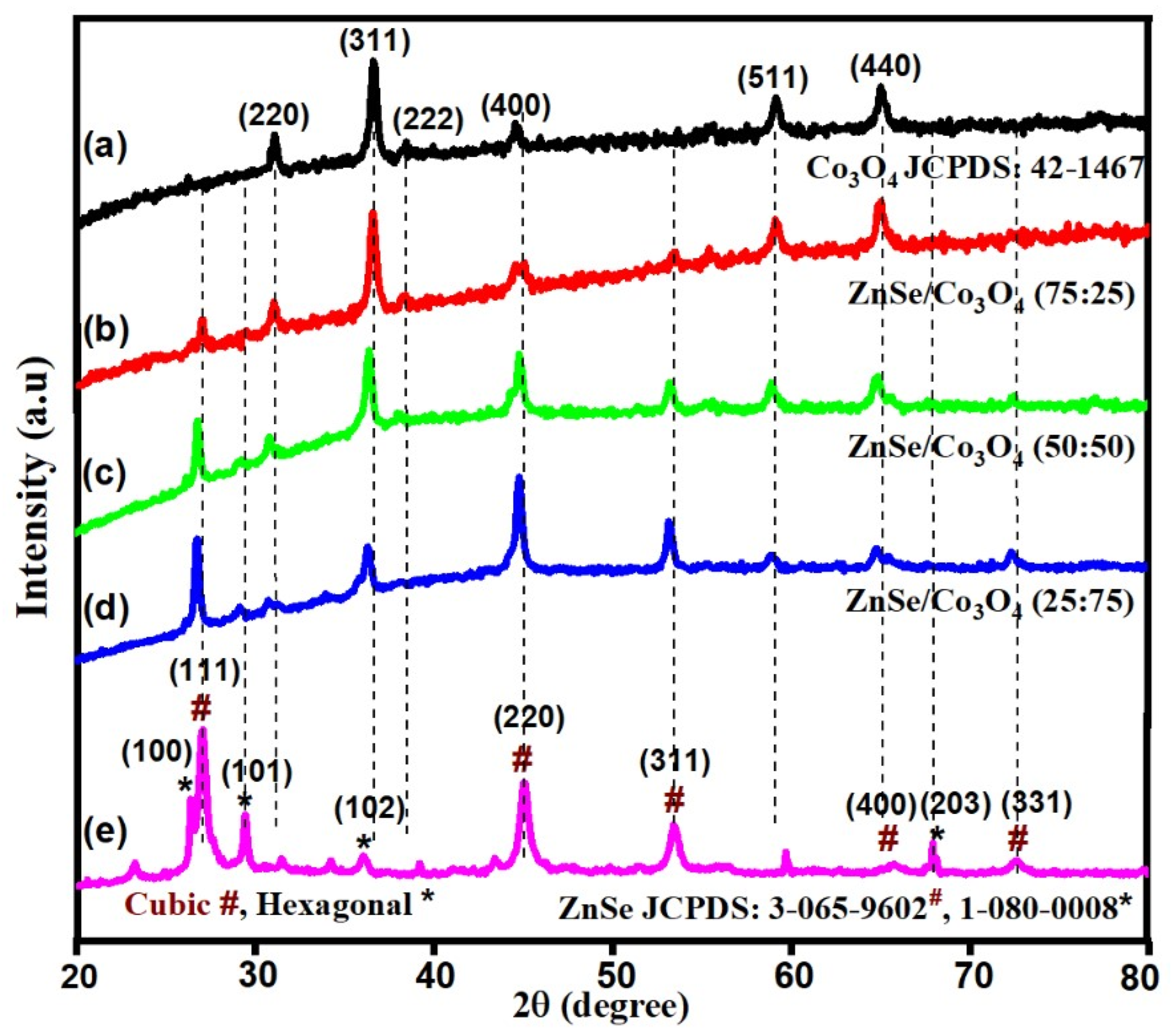
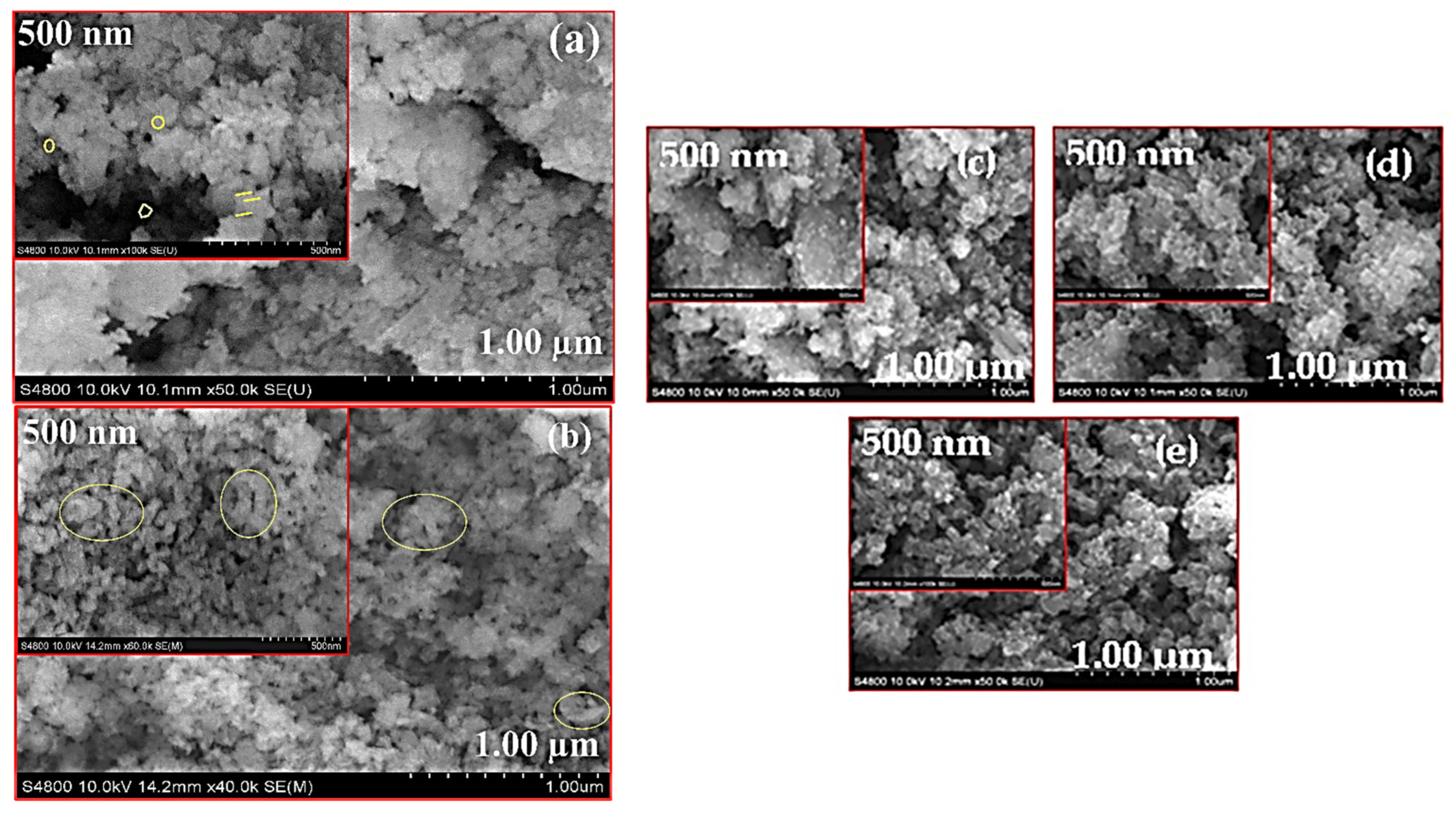
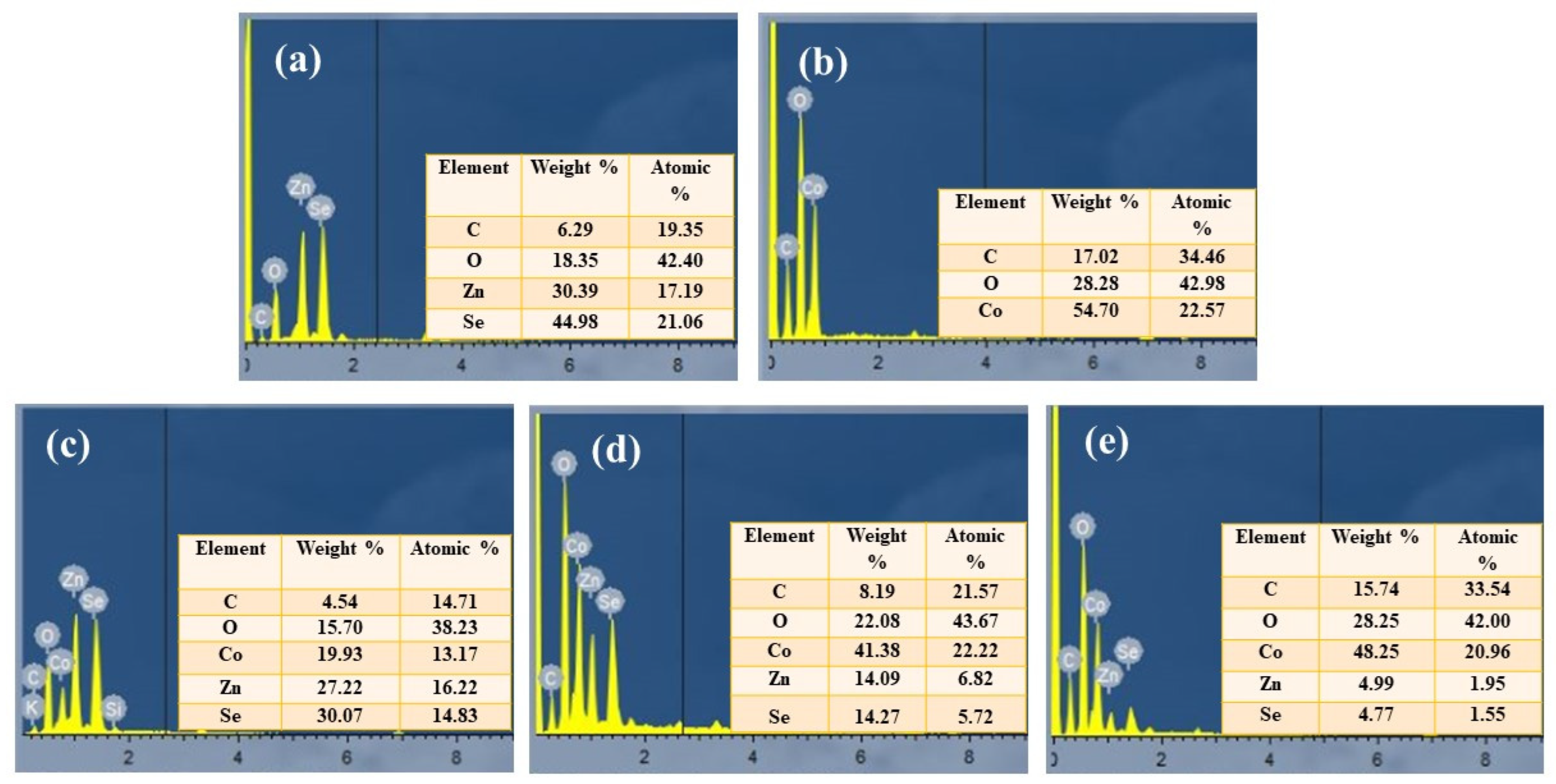
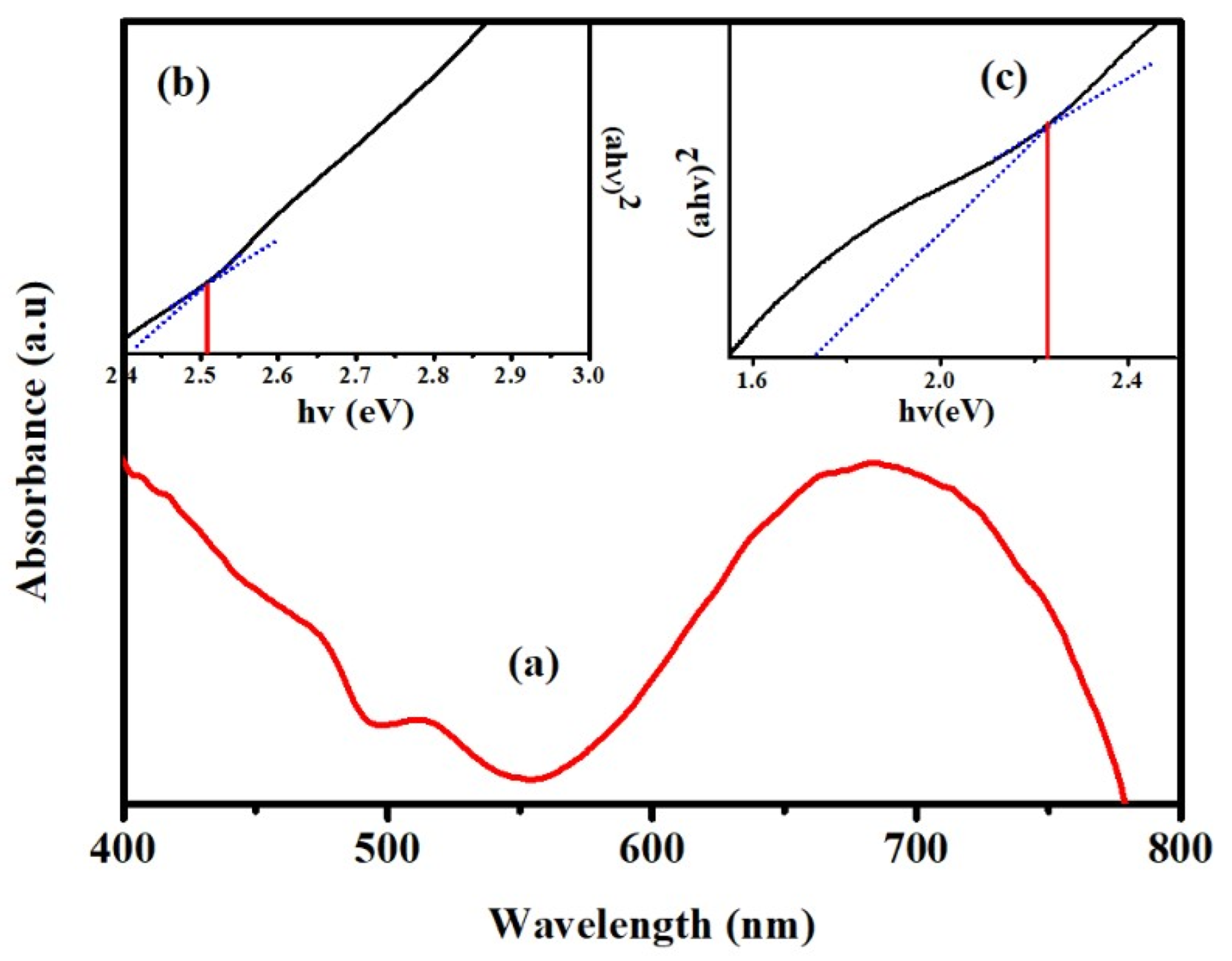


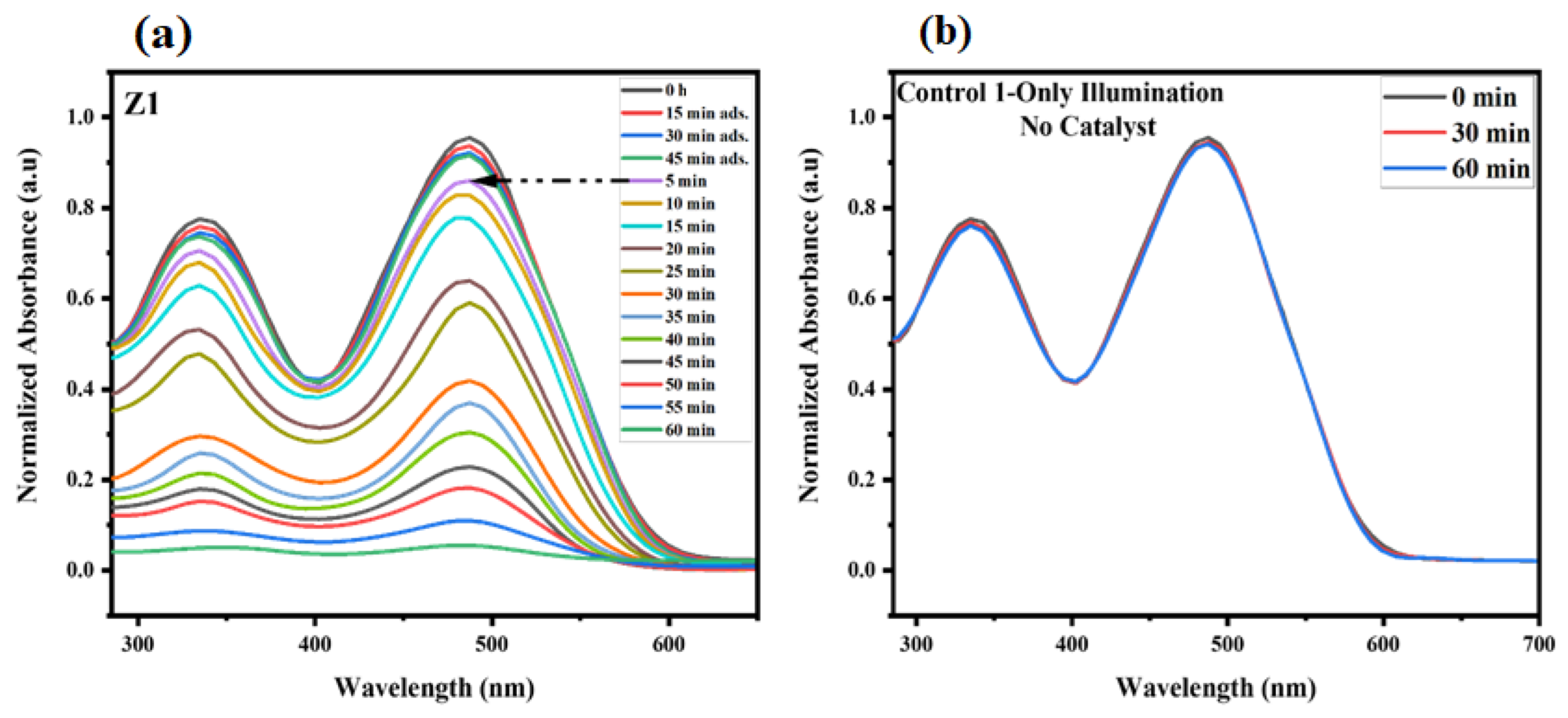
| Sample Name | Temperature | Time | Chemical Used |
|---|---|---|---|
| ZnSe | 120 °C | 2 h | Zn powder, Se powder and KOH |
| Co3O4 | 120 °C | 20 h | CoCl2·6H2O and CH4N2O |
| Sr. # | Composite Name | % of ZnSe by Weight | % of Co3O4 by Weight |
|---|---|---|---|
| 1 | Z1 | 75 | 25 |
| 2 | Z2 | 50 | 50 |
| 3 | Z3 | 25 | 75 |
Publisher’s Note: MDPI stays neutral with regard to jurisdictional claims in published maps and institutional affiliations. |
© 2022 by the authors. Licensee MDPI, Basel, Switzerland. This article is an open access article distributed under the terms and conditions of the Creative Commons Attribution (CC BY) license (https://creativecommons.org/licenses/by/4.0/).
Share and Cite
Zia, A.; Naveed, A.B.; Javaid, A.; Ehsan, M.F.; Mahmood, A. Facile Synthesis of ZnSe/Co3O4 Heterostructure Nanocomposites for the Photocatalytic Degradation of Congo Red Dye. Catalysts 2022, 12, 1184. https://doi.org/10.3390/catal12101184
Zia A, Naveed AB, Javaid A, Ehsan MF, Mahmood A. Facile Synthesis of ZnSe/Co3O4 Heterostructure Nanocomposites for the Photocatalytic Degradation of Congo Red Dye. Catalysts. 2022; 12(10):1184. https://doi.org/10.3390/catal12101184
Chicago/Turabian StyleZia, Adeel, Abdul Basit Naveed, Aftab Javaid, Muhammad Fahad Ehsan, and Azhar Mahmood. 2022. "Facile Synthesis of ZnSe/Co3O4 Heterostructure Nanocomposites for the Photocatalytic Degradation of Congo Red Dye" Catalysts 12, no. 10: 1184. https://doi.org/10.3390/catal12101184
APA StyleZia, A., Naveed, A. B., Javaid, A., Ehsan, M. F., & Mahmood, A. (2022). Facile Synthesis of ZnSe/Co3O4 Heterostructure Nanocomposites for the Photocatalytic Degradation of Congo Red Dye. Catalysts, 12(10), 1184. https://doi.org/10.3390/catal12101184







